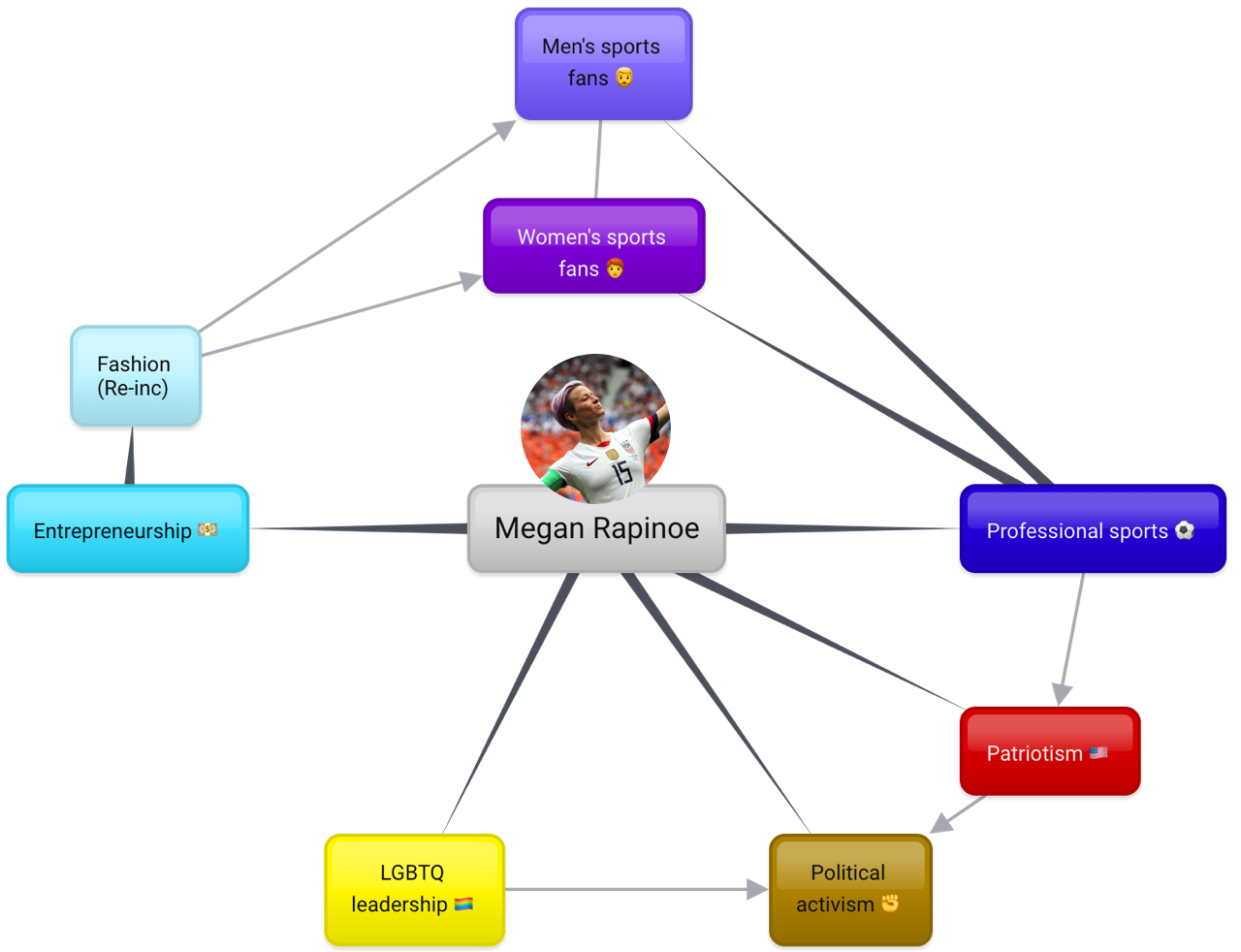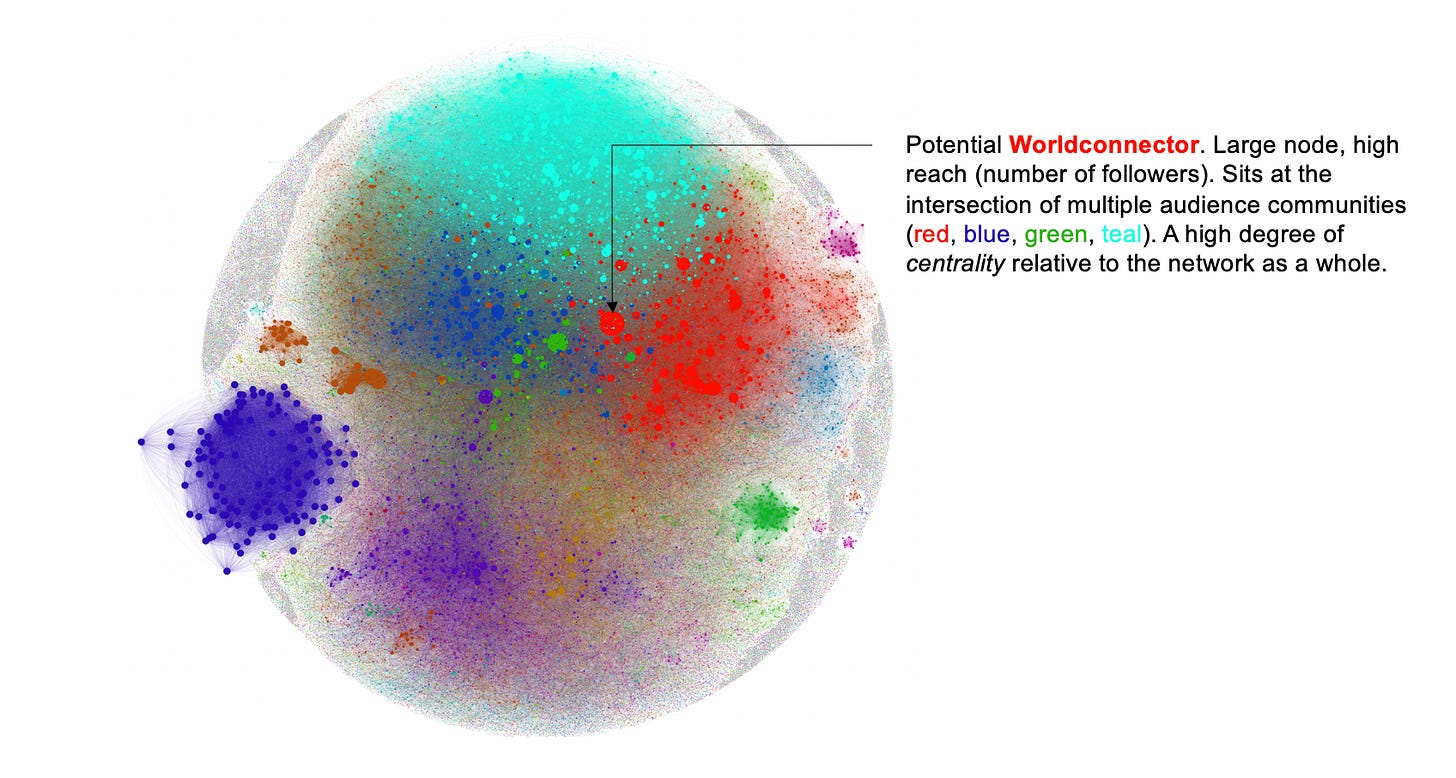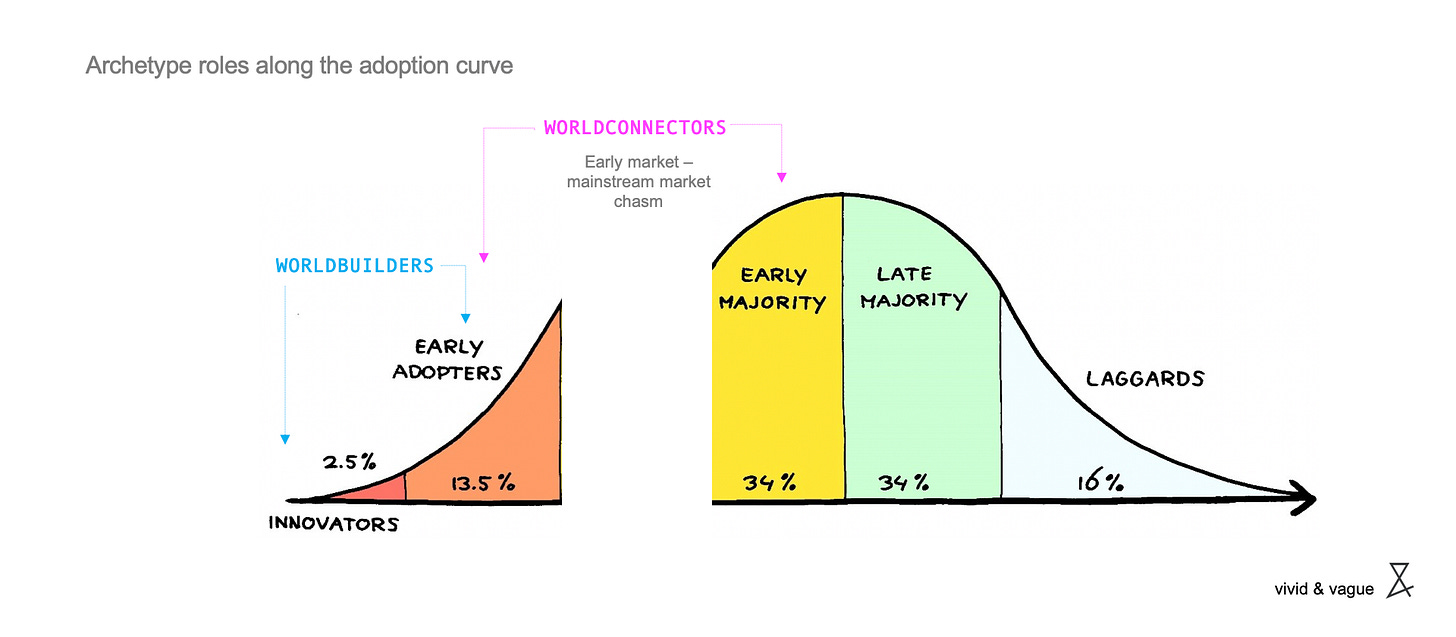Worldconnectors & the new mainstream
Or, strategies built for authenticity, audiences, and intersections
Hey V&V fam ✌️
I spend many of my waking hours analyzing data, studying trends, researching consumer behavior, and mapping pop culture — trying sharpen ideas about how it all fits together. I want to bring that to your inbox.
Today’s essay is a fun one, I think. I’m excited to hear your thoughts about it.
Welcome to the 29 new members joining us this week. If you’ve found your way here but haven’t subscribed yet, join in👇
Worldconnectors & the new mainstream
Several weeks ago I read a piece from Packy McCormick’s great newsletter, Not Boring, in which he wrote, “There are two ways to predict the future: you can call it or you can build it.” He smartly outlined two archetypes of leadership and entrepreneurship: Shotcallers versus Worldbuilders.
To paraphrase Packy:
Shotcallers are brash and bold. They find a big market, guarantee that they’re going to transform it, and try to spend their way into making that happen.
Worldbuilders are visionary. They predict something non-obvious about the way the world is moving before others see it, then create a wedge into the market and leverage it into a much larger opportunity — all while outlining their vision in public or for their team.
Muhammad Ali was a Shotcaller; he announced he would knock you out, and then he did. Jeff Bezos is a Worldbuilder; he recognized the massive opportunity in eCommerce, started with books as the “first best product” to sell online, and then ruthlessly executed on his vision until he parlayed a bookstore into an empire of video streaming, grocery stores, cloud computing, and more.
In his essay, Packy crowns the Worldbuilder as the better archetype, particularly in the context of consumer tech. I loved the framework and it got me thinking: who would be on my Worldbuilder list? I started to jot down some names and added examples throughout the week as they popped in my head. When I scanned my list a couple of days later, though, I realized most of them didn’t really fit the Worldbuilder profile, but represented some other persona. I DM’d Packy.
“What do you think about the idea of Worldconnectors?”
“Write it,” he said. Here we are.
I’m introducing Worldconnectors not in opposition to Shotcallers or Worldbuilders, but as another archetype for consideration.
Worldconnectors are polymaths. Their initial wedge is a unique talent or strain of intellect that attracts an audience, which they then leverage to spread into other interest communities. Their success is not a function of a strategic plan, but compounds over time with their capacity for cross-pollination and consistently great timing.
Why should we care? Where the Worldbuilder accomplishes feats of ambition and engineering, the Worldconnector is a master of authenticity and connection. They find a way to say and create what they want, preserve their independence while doing it, and prosper along the way. I believe that’s important for the culture and society, important for business, important for our wellbeing. And it’s important we see how all of those things are connected too.
Ok, let’s introduce a Worldconnector. Our first example is...John Mayer.
Let me explain. Maybe you love his music, maybe you loathe it. Maybe he frustrates you because he’s a guitar virtuoso who makes straightforward pop tunes. I know people with very strong Mayer emotions. The dude can be polarizing. But it’s undeniable that he possesses a type of genius.
Let’s break it down:
Mayer has Millennial fans who grew up with him, he has Gen Z fans who love his music and his collaborations with emerging pop artists, and he’s got their parents, late Gen X Dead Heads who’ve totally embraced his unlikely role in Dead & Company. The guy who wrote “Your Body is a Wonderland” is now welcomed by the jam band faithful as Jerry Garcia’s successor. That, my friends, is reaching across the aisle.
He collects vintage timepieces and is an authority among the watch-obsessed community. He’s a stealth fashion influencer, suffusing personal style through all of his projects and appearances. He is both a connoisseur of classics and a notorious hypebeast. As my friend @euko noted, the web gets more interesting the further you follow each thread: “Even his fashion interest alone connects him to everything from japanese forms to blockbuster movies. Mayer loves Acronym, a technical apparel brand inspired by functionality and martial arts, whose founder designs pieces for the Fast and the Furious franchise as well as Death Stranding, one of the biggest video games of the last year.”
Mayer is bros with Dave Chapelle and tours with him, performing hybrid concerts and comedy shows. And one of his best friends is Andy Cohen, the maestro of Bravo, which is extremely on-brand as far as friendships go, given Mayer’s lengthy history of tabloid exploits and celebrity drama.
As he settles into his own brand of maturity, Mayer’s most intriguing quality is ambiguity. He has one foot cemented in gossipy, plasticized mainstream culture, while another dances in and out of various niches, most notably the cult of “The Dead,” whose dancing bears and stealie skull are some of the strongest symbols of counterculture in American history. There are four generational cohorts who care about John Mayer. He’s a kind of portal from Gen Z back to the ‘60s, a link from the acid tests to Insta stories.
All of this coalesces in his homespun variety show on Instagram, “Current Mood.” I think it’s one of the most interesting new media projects of the last couple years.

There are a lot of Mayer data points here. Let’s visualize it:
John Mayer
Wolrdconnector nickname: “The Celeb Everyman”
Network type: Sparse Clustering
Platform of choice: Instagram

What makes a Worldconnector?
Unwavering authenticity. They can’t be anything other than themselves. No employer or brand partnership or single venture could ever sustain their curiosity or potential; their own identity is paramount.
Social instincts. They understand that conversation sets the conditions for growth. It’s not a matter of extroversion, necessarily, but a need to express deep insights or discoveries, and to receive information in return through a social feedback loop.
Audience understanding. They have a knack for attracting and consolidating audiences, across a wide range of demographics or interest profiles. And they respect the audience. They understand that, like them, their audience and the individuals that compose it are not one dimensional nor naive. (The same can’t be said of many brands and media outlets.)
Zeitgeist synthesis. They connect the dots more quickly, or in a more interesting way, than the rest of us. They understand how the latest news or emergent trends link to their work and the cultural moment.
Polymathism. They do numerous things incredibly well or have a deep knowledge of many subjects. They walk the walk. They can draw on a reservoir of skills or charms when a problem, opportunity, or cultural opening presents itself. In this way, they create their own luck.
Now, let’s look at some other examples.
Sam Harris
Worldconnector nickname: “The mind guide”
Network type: Vertical Integration
Platform of choice: Podcasting

Working from a background in neuroscience, Harris branches into various intellectual pursuits and commercial projects that all tie back to theory of mind. He publishes books, talks at events, hosts a podcast, and created the Waking Up App. He’s a member of the “Intellectual Dark Web” but speaks to a growing audience of 1.3M Twitter followers right out in the open. In any venue, he can go into politics or spirituality or tech, and it all feels integrated and authentic. For a guy that seems to be in many places all at once, he’s a master of non-duality (must be all the meditation).
Megan Rapinoe
Wolrdconnector nickname: “The Most Vocal & Valuable Player”
Network type: Gradual Grower
Platform of choice: Instagram

Rewind a few years. When you thought of women’s soccer, you probably didn’t think of politics. When you thought of the LGBTQ community, you probably didn’t think sports. And when you thought of the women’s national soccer team, you probably didn’t think about the next generation of boys idolizing them.
Megan Rapinoe makes you think again.
With her amazing performances on the big stage, her primetime personality, and her activism and irreverence off the field, she’s connected fans across genders and interest profiles. And her ambition and crossover of worlds now leads her into entrepreneurship — she is cofounder of re-inc., a gender-neutral lifestyle brand.
Action Bronson
Wolrdconnector nickname: “The Cultural Savant”
Network type: Fractal Flywheel
Platform of choice: SVOD

This guy manages to be all over the map but makes perfect sense while doing it. When you zoom out, his profile seems a bit scattered, but zoom in and you’ll find the connections are pretty tight. You could spend a day with him (IRL or watching Viceland or on Instagram) flicking through vintage records, watching 1980’s action flicks, talking early aughts Yankees, or debating the nuances of truffle species and natural wines. Each one of his interests feeds the next and his audience flywheel picks up speed accordingly.
Worldconnectors are entrepreneurs of the intersection, and intersections are the new mainstream
Whereas Worldbuilders bend the world toward their vision through impeccable planning and execution, Worldconnectors deftly navigate opportunities with a sort of finely tuned echolocation. They send out signals, detect where there’s most resonance, and apply their most compatible talent or knowledge to thrive in those spaces, at least for a while.
Those spaces tend to be cultural intersections: where hippie meets hypebeast, where Michelin stars meet psychoactive plants, where mindfulness meets tech. Conscious or not, the Worldconnector approach is basically a whitespace strategy:
Cultural intersections are less crowded: find the pockets and overlaps between mass movements, and you just might claim something ownable
Cultural intersections are more defensible: they require exceptional authenticity, personality, and versatility — a harsh atmosphere for most brands to thrive in. Plus, a career of intersection-hopping gives you a better chance to outrun the AI.
Cultural intersections are compounding bets: when they payoff and start to get crowded, whoever is directing the traffic benefits from numerous audiences colliding and multiplying.
The mainstream, as we knew it, is gone. That old mainstream, reliant on the mass media model, was killed by the internet. In the new mainstream, we invest much of our attention along the long tail and check back in with the masses when something compelling enough forms a new homepage for the culture. It’s a combinatorial mainstream now, and it seems to shatter almost weekly, then reform with a new mix of components. Algorithms surface deep cuts or pop-adjacent stuff that feels made just for us, and only steer us back toward the Consensus Content™ when there are enough signals that a thing is reaching a critical mass of interest.
A version of the new mainstream might look something like this:


Or it might feel like this: surf.city
In this mainstream, we enjoy more freedom and fluidity in our consumption identities. Demographics don’t dictate behaviors and tastes anywhere near as much as they used to.
In the old model, saturation was achievable. With the right exposure and enough media spend, one could penetrate a very high percentage of the mainstream. Set a crude plan to reach American women 25-44 and, voila, you’d probably get your money’s worth. But the center could not hold. Now, any given piece of content, cultural event, or celebrity might register with multiple sub-communities — but it’s highly unlikely to capture a majority of public awareness.

With mass media corroding and audience fragmentation on the rise, the Worldconnector is a force for coherence. They save niche communities from becoming islands and show the rest of us how certain stuff on the fringes is actually hyper-relevant to “the now.” While Worldbuilders and Shotcallers predict the future, Worldconnectors consolidate the present.
How? By reaching people directly and immediately. New media trends make this possible (and scalable).
Premium social: Attention moving away from general public feeds, more focus on community building, incentives to create high quality or exclusive content
Direct-to-audience publishing and broadcasting: Rise of podcasting, newsletters, live streaming
Democratization of eCommerce: Stripe, Shopify, Gumroad, et. al make it possible to sell direct to an audience with near-zero friction
Diminishing trust in MSM: We don’t want gatekeepers of information and content, we want decentralized expertise and entertainment
Worldconnectors force us to rethink influence
Worldconnectors don’t necessarily set out to build. They set out to think, to create art or synthesize information, to infect others with ideas and feelings. They are highly generative and prolific. But their power is not a matter of top-down impact; they don’t make things go viral at will. Worldconnectors are experts at setting the conditions for organic virality.
Studying Worldconnectors can help shake us free from the lazy assumption that follower counts and impressions = influence. We like these metrics because they are a short cut, an abstraction from the living, breathing, sometimes very messy network that underlies any system where people are involved. But — as the Worldconnector shows us — we’re glazing over a lot of sociological and mathematical meaning by being so obsessed with pure reach.
A quick look at social network analysis and graph theory. Here, Worldconnectors are unique, highly valuable nodes in a network.

Earlier, we looked at the qualities that make a Worldconnector. What’s cool is that Worldconnectedness is actually measurable, through quantities like density and centrality:
A Worldconnector is super well-connected
Density refers to the "connections" between participants. Density is defined as the number of connections a participant has, divided by the total possible connections a participant could have. For example, if there are 20 people participating, each person could potentially connect to 19 other people. A density of 100% (19/19) is the greatest density in the system. [Wikipedia]
A Worldconnector is highly interactive
Centrality focuses on the behavior of individual participants within a network. It measures the extent to which an individual interacts with other individuals in the network. The more an individual connects to others in a network, the greater their centrality in the network. [Wikipedia]
Consider high density and centrality combined with unwavering authenticity and advanced zeitgeist synthesis, and you can start to sense how much magnetism and leverage a Worldconnector has.
Literal thinking might lead you to apply Worldconnector concepts to influencer strategy. But I find it more interesting to use Worldconnector thinking as a mental model to help solve problems around growth, scaling, and branding. How could you transpose Worldconnector qualities from a person to the brand you’re building?

When you boil it all down, what are Worldconnectors really good at? Closing the chasm. In the new, combinatorial mainstream, someone’s gotta help us connect the dots, and fast.
Huge thanks to Packy for featuring this piece, I hope it was on brand (Not Boring). And thank you to Paige Geffen, Eugene Ko, and Adam Saewitz for helping to sharpen some of the thinking here.
Honorable mention. Other potential Worldconnectors who came up while brainstorming(in no particular order). Who would be on your list?
Joe Rogan
Oprah Winfrey
Dax Shepard
Chrissy Teigen
Donald Glover
Dev Hynes
Lena Waithe
Howard Stern
Awkwafina
AOC
Spike Lee
Thanks so much for reading. Get in touch (@marc_it) if you want to talk Worldconnectors - I know I’ve probably missed some good ones, so would love to hear your suggestions. And if you enjoyed Vivid & Vague this week, tell a friend ✌️




Really interesting thank you. I'm drawing a blank on examples right now, but I feel you've put a name to something I see with increasingly regularly. Particularly noticeable when they pop-up in more than one of your own diverse interests.
Jack Welch, Michael Eisner, Steve Case and Meg Whitman may considered as worldconnector?